40 carbohydrates on food labels
Reading Food Labels for Carbohydrates - dummies to find the amount of carbohydrates in your foods, follow these steps:\r\n\r\n \tlook for the line that reads \"total carbohydrate\" on the label.\r\n\r\nthe value on this line will tell you how many grams of carbohydrates are in one serving of the food.\r\n \tcheck the number of servings per container to see if your package has one or more … How to Use the Nutrition Facts Label - Diet Doctor This chocolate has 14 grams of carbohydrates per serving. 3. Calculate net carbs per serving Third, check the grams of dietary fiber per serving (circled in green, above). Subtract the fiber (green) from the total carbohydrates (blue) to get the net carbs. This chocolate has 9 grams of net carbs per serving (14g carbs - 5g fiber = 9g net carbs).
How to Read Carbohydrates on Nutrition Labels|How to Read ... Breakdown of the Label If we break down the carbohydrates section of a nutrition label it usually has 3 parts. Carbohydrates -Sugars -Dietary fibre The top carbohydrates row is the total amount of carbs present. Made up of all the sugars, dietary fibre and starch, which is the remaining amount after the sugar and fibre.
:max_bytes(150000):strip_icc()/LabelA2-56a5c0f65f9b58b7d0de5351.jpg)
Carbohydrates on food labels
PDF Challenges with Carbohydrate Counting & Food Labels • In diabetes meal planning, 1 serving of a food with carbohydrate has about 15 grams of carbohydrate •Check serving sizes with measuring cups and spoons or a food scale •Read the Nutrition Facts on food labels to find out how many grams of carbohydrate are in foods you eat. Carbohydrate Servings Reading labels - Diabetes UK Key points Always look at the 'total carbohydrate' on the label when carb counting. This will make sure you are counting both the complex (starchy) and simple (sugary) carbs in your food. Both will raise your blood glucose (blood sugar) levels, and need to be matched with insulin. Interactive Nutrition Facts Label - Food and Drug ... Sodium 430mg 17% Total Carbohydrate 46g 25% Dietary Fiber 7g Total Sugars 4g 4% Includes 2g Added Sugars Protein 11g 10% Vitamin D 2mcg 20% Calcium 260mg 35% Iron 6mg 6% Potassium 240mg The % Daily...
Carbohydrates on food labels. How To Figure Out The Carbs On Nutrition Labels - Eat Out ... Mar 01, 2011 · Carbs on a label also refer to fiber and the sugars that are the composition of the food — like the natural sugars that are found in fruits, vegetables, grains, and milk. Carbs are the body’s main source of fuel — it’s the simple added sugars like table sugar and syrups (and the foods that contain them) that give the quick rise and fall in energy levels. How to Read a Food Label | Atkins When you look at most food labels, you won't see a number representing the grams of carbs that impact your blood sugar. These high-glycemic carbs are the carbs that you need to count known as the Net Carb count. Fortunately, you don't have to be a food scientist or math whiz to figure it out. Understanding Food Labels | The Nutrition Source | Harvard ... Under the Food Allergen Labeling and Consumer Protection Act of 2004, eight major food allergens—milk, fish, tree nuts, peanuts, shellfish, wheat, eggs, and soybeans—are required to be listed in a "contains" statement near the Ingredients list if present in a food. An example would be "contains wheat, milk, and soy." Understanding food labels | Diabetes UK All carbohydrates raise blood glucose levels. Labels on the front don't include the amount of carbs, so check the label on the pack for the total carbohydrate, which includes carbohydrates from starchy food as well as sugars.
How are Carbohydrates & Dietary Fiber Labelled on Foods ... The fibers listed below are the most common sources being added to food and can be declared on the Nutrition Facts label as dietary fiber. FDA approved isolated and synthetic non-digestible carbohydrates Gum Acacia Alginate Apple Fiber Bamboo Fiber Carboxymethylcellulose Corn Hull Fiber Cottonseed Fiber Galactooligosaccharides How to Read Carbohydrates on Food Labels - GlycoLeap When learning how to read carbohydrates on food labels, always remember that 1 serving of carbohydrate is equal to 15 g of carbohydrates. If you want to have a snack, it is recommended to eat no more than 1 to 2 servings of carbohydrates in one sitting. That would be around 15 to 30 g of carbohydrates. Snack = 15 - 30 g of carbohydrate Food Labels and Counting Carbs - dummies Total Carbohydrate is listed in grams. Because %Daily Value is written in bold and off to the right side of the label, and lined up neatly with the actual amount, it is easy to allow your eye to zero in on the %Daily Value rather than the actual amount in grams. What's the Difference between Carbohydrates & Sugar on ... Carbohydrates - 3g. Of which sugars - 2.8g. For this example, you'd count 3g carbohydrates and the sugar amount of that total is 2.8g. Sugar is found in many forms such as sweets, fizzy drinks and desserts. However sugar is also found in other foods like sauces, condiments, bread and other savoury foods. Always check labels on foods that ...
Reading Food Labels | ADA - American Diabetes Association The Nutrition Facts labels on foods are really the key to making the best choices. We'll cover the basics so that these labels make shopping easier for you. Get started Understanding Carbs You've heard it all. From carb-free to low-carb, to whole and empty carbs, it's hard to know what it all means. Learn more Food & Blood Sugar Reading food labels: Tips if you have diabetes - Mayo Clinic Less than 5 grams of carbohydrates a serving Do the math Pay attention to serving sizes. The serving sizes listed on food labels may be different from the serving sizes in your meal plan. If you eat twice the serving size listed on the label, you also double the calories, fat, carbohydrates, protein, sodium and other ingredients. How to Understand and Use the Nutrition Facts Label | FDA Dietary fiber, vitamin D, calcium, iron ad potassium are nutrients on the label that Americans generally do not get the recommended amount of. They are identified as nutrients to get more of.... Understanding Food Nutrition Labels | American Heart ... The U.S. Food and Drug Administration (FDA) regulates the Nutrition Facts label seen on packaged foods and drinks. In 2016, the FDA released changes to the label to make it easier to see how many calories and added sugars are in a product and to make serving sizes more realistic.
LABEL READING: CARBOHYDRATES AND SUGARS — Theresa Wright ... "Sugar" is one of two subheadings beneath "Total Carbs" on a food label. A serving's total sugar content appears in grams but not as a percentage of your daily intake. The word "sugar" includes a variety of simple sugars, which are compounds that your body can easily break down for immediate use.
What Is the Difference Between Sugar & Carbs on Food Labels? Dietary fiber is part of the total carbohydrates, but unlike sugar and starch, fiber is not digestible. The percent daily value corresponds to 25 grams. Some food labels also make the distinction between soluble and insoluble fiber, the two types of fiber found in foods.
Food Labels: Fat & Cholesterol | Home & Garden Information ... For more information on food labeling request: HGIC 4056, Reading the New Food Labels; HGIC 4057, Determining Nutritional Value of Foods; HGIC 4059, Food Labels: Carbohydrates; HGIC 4060, Serving Sizes for Special Diets; HGIC 4061, Nutrient Claims on Food Labels; and HGIC 4062, Nutrient Density. Document last updated on 1/20 by Gaby Lopez.
Food Labels: Carbohydrates - HGIC@clemson.edu According to nutrition experts, carbohydrates should provide 45-65% of your total daily calories. That means carbohydrates should supply 900 calories or more in a 2,000-calorie-a-day diet. Facts on Food Labels Food labels contain clues to a food's carbohydrate content, including the amount per serving.
Carb vs. Sugar: How to Understand Nutrition Labels 21 Sept 2017 — Carbohydrates are actually comprised of three nutrients: carbohydrates, fiber, and sugar. You may, and will see, foods that are very low in “ ...
How Do They Calculate Calories on Food Labels? - Food and ... Calories on food labels The 1990 Nutrition Labeling and Education Act (NLEA) for the first time required that food manufacturers put the amounts of nutrients and calories on the package label. Instead of using the bomb calorimeter method to establish calories in foods, manufacturers began using an easier process: the Atwater method.
Food Labels | CDC If you eat the whole thing, you are eating 8 times the amount of calories, carbs, fat, etc., shown on the label. Total Carbohydrate shows you types of carbs in the food, including sugar and fiber. Choose foods with more fiber, vitamins, and minerals. Choose foods with lower calories, saturated fat, sodium, and added sugars. Avoid trans fat.
Learning To Read Labels :: Diabetes Education Online On a nutrition food label, subtract the fiber from the total carbohydrate amount. When you read food labels, the grams of sugar are already included in the total carbohydrate amount, so you do not need to count this sugar amount separately. The grams of sugar listed include both natural sugars, from fruit or milk, and added sugars.
How do you read net carbs on labels ... "Other carbohydrate" is listed on some food label's Nutrition Facts panel underneath "total carbohydrate" and refers mainly to complex carbohydrates, commonly called starches. (If a food contains sweeteners called sugar alcohols - xylitol, mannitol, sorbitol - they also are included in this group.)
Get Smart On Carbs | ADA - American Diabetes Association In short, the carbs we consume impact our blood sugar—so balance is key! There are three main types of carbohydrates in food—starches, sugar and fiber. As you'll see on the nutrition labels for the food you buy, the term "total carbohydrate" refers to all three of these types.
Understanding Nutritional Labels | Beaumont | Beaumont Health Food labels will help you understand how many carbohydrates are in your food and how much fiber and sugar are included as well. As a general rule, the more fiber and the less sugar there is in the carbohydrate, the better it is for your body. Under the carbohydrate listing on food labels, you will the following as well: Dietary fiber Sugars
Low Carb Guide to Understanding Nutrition Labels - Virta Health 1 Nov 2017 — The carbohydrate count is given as total grams, and then broken down into carbs from fiber and sugar. Focus on total carbohydrate. Sugar should ...
PDF Read the Food Label for Carbohydrates Read the Food Label for Carbohydrates Food labels help you choose foods that are lower in calories and in carbohydrates and sweeteners. Here is a food label for a 12-ounce regular soda. The label provides lots of useful information. 1. Serving Size and Number of Servings The serving size is 12 ounces. There’s 1 serving in this container. 2.
Interactive Nutrition Facts Label - Food and Drug ... Sodium 430mg 17% Total Carbohydrate 46g 25% Dietary Fiber 7g Total Sugars 4g 4% Includes 2g Added Sugars Protein 11g 10% Vitamin D 2mcg 20% Calcium 260mg 35% Iron 6mg 6% Potassium 240mg The % Daily...
Reading labels - Diabetes UK Key points Always look at the 'total carbohydrate' on the label when carb counting. This will make sure you are counting both the complex (starchy) and simple (sugary) carbs in your food. Both will raise your blood glucose (blood sugar) levels, and need to be matched with insulin.
PDF Challenges with Carbohydrate Counting & Food Labels • In diabetes meal planning, 1 serving of a food with carbohydrate has about 15 grams of carbohydrate •Check serving sizes with measuring cups and spoons or a food scale •Read the Nutrition Facts on food labels to find out how many grams of carbohydrate are in foods you eat. Carbohydrate Servings

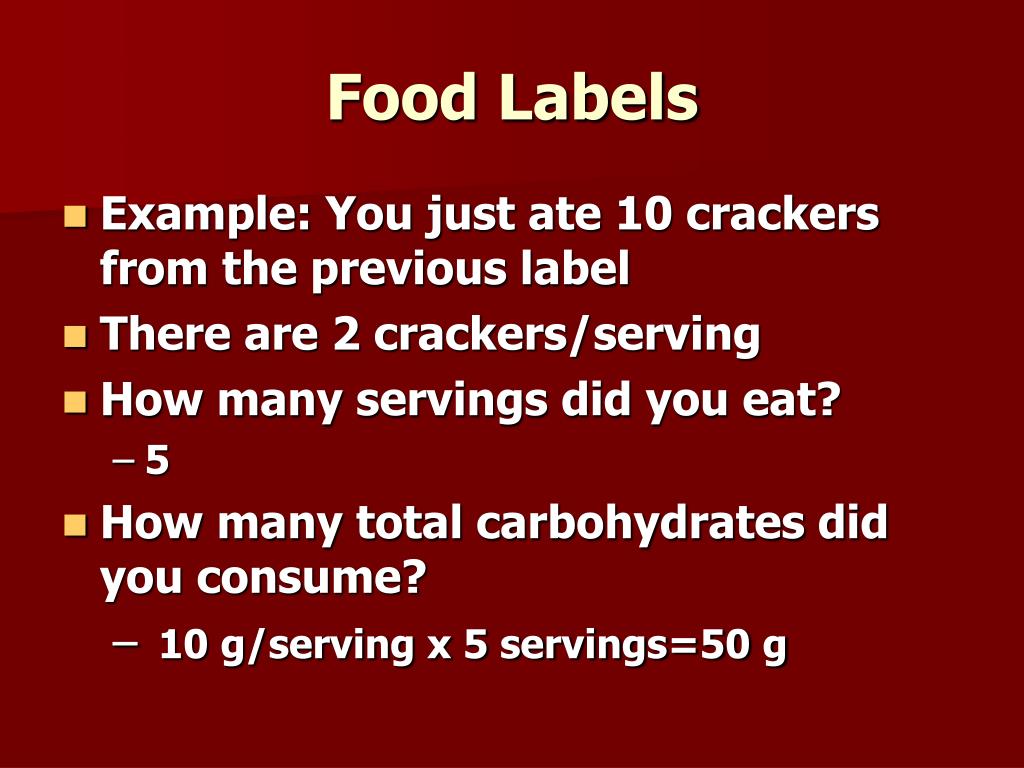
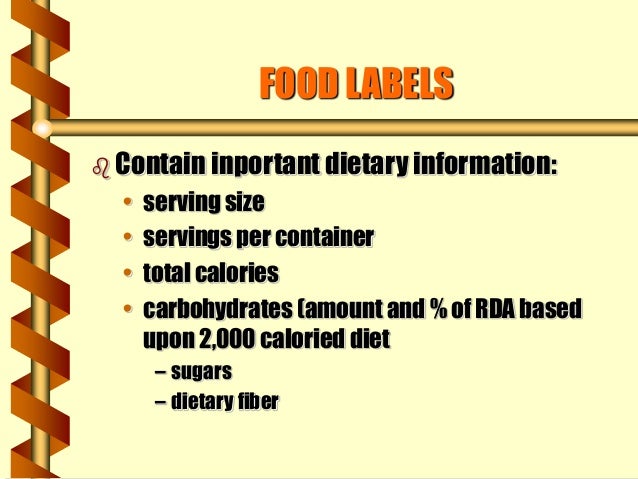
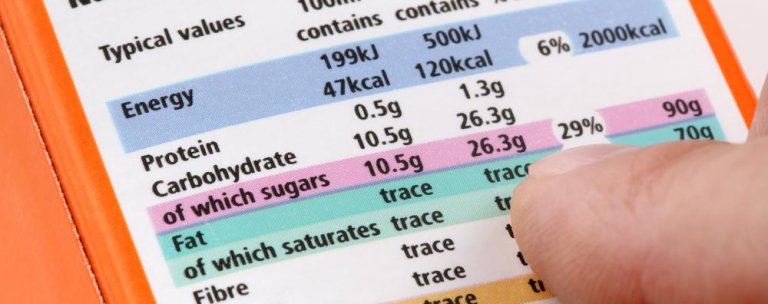
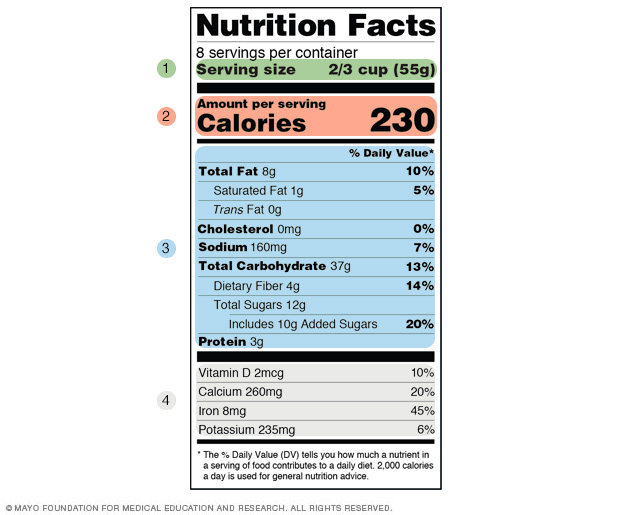


![Zero Carbs Foods Cheat Sheet by [deleted] - Download free from Cheatography - Cheatography.com ...](https://media.cheatography.com/storage/thumb/deleted-2754_zero-carbs-foods.600.jpg)

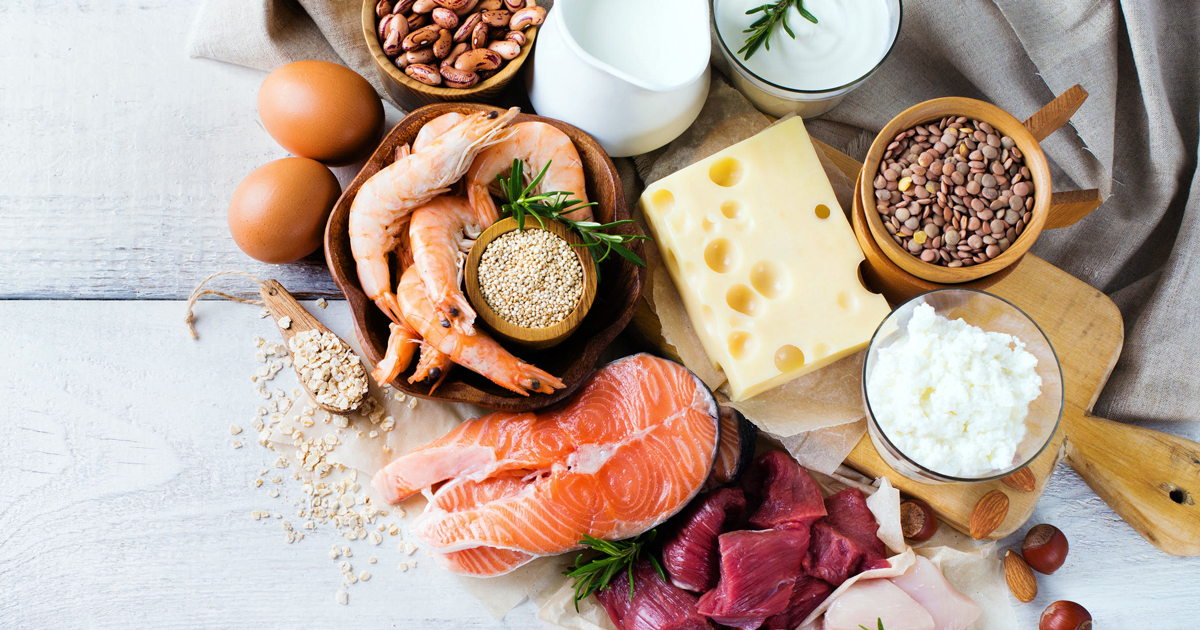

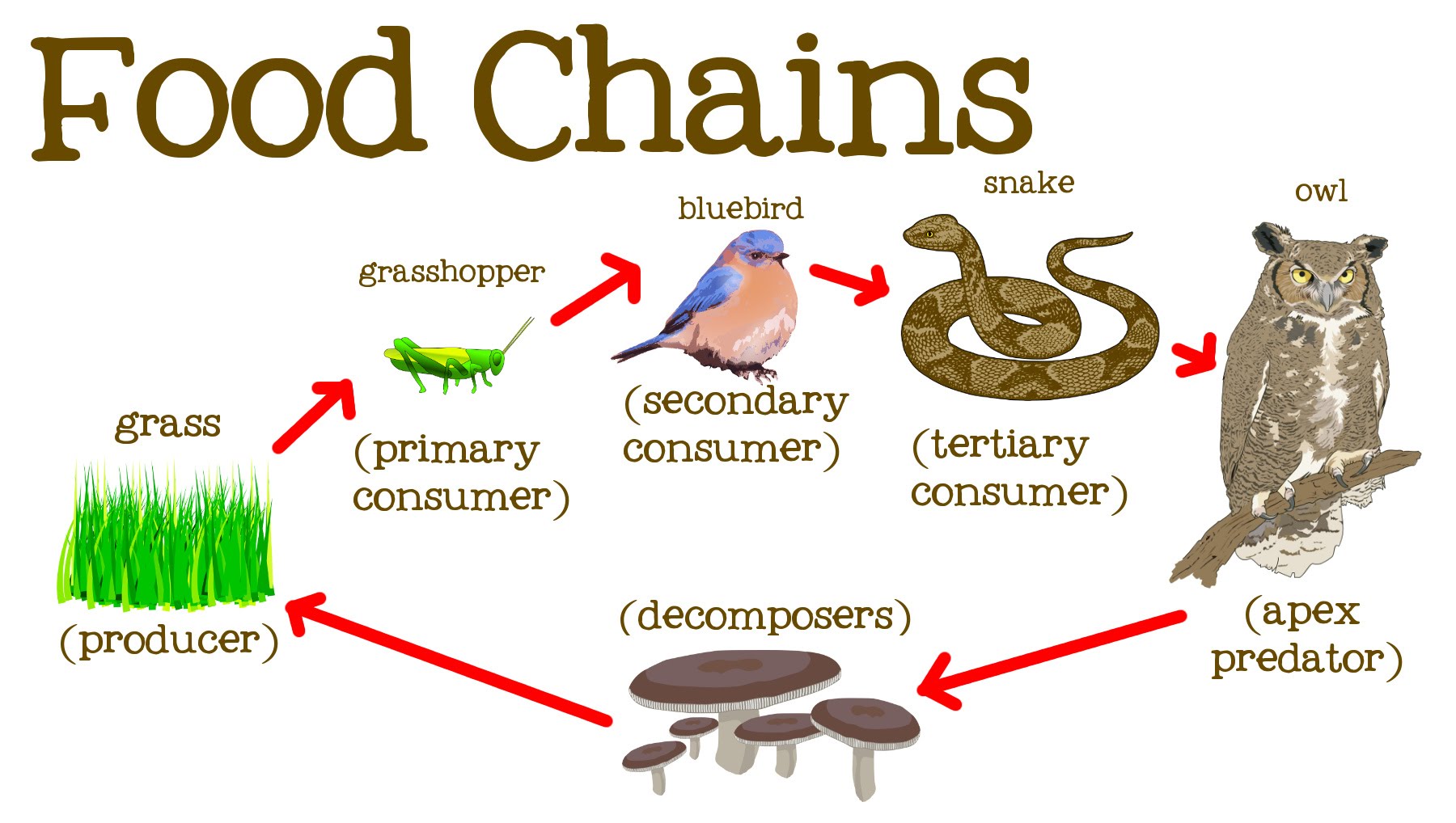
Post a Comment for "40 carbohydrates on food labels"